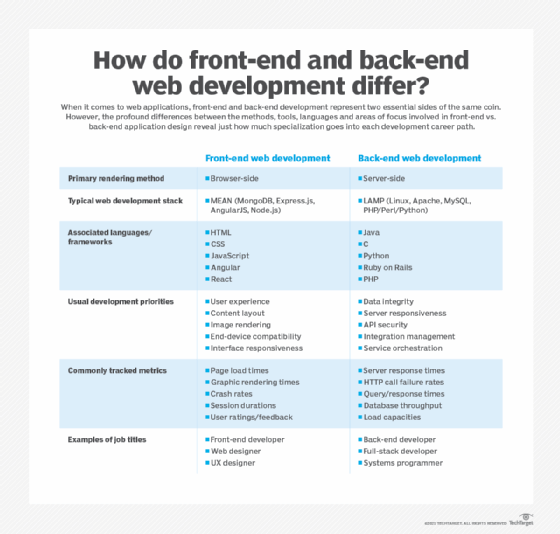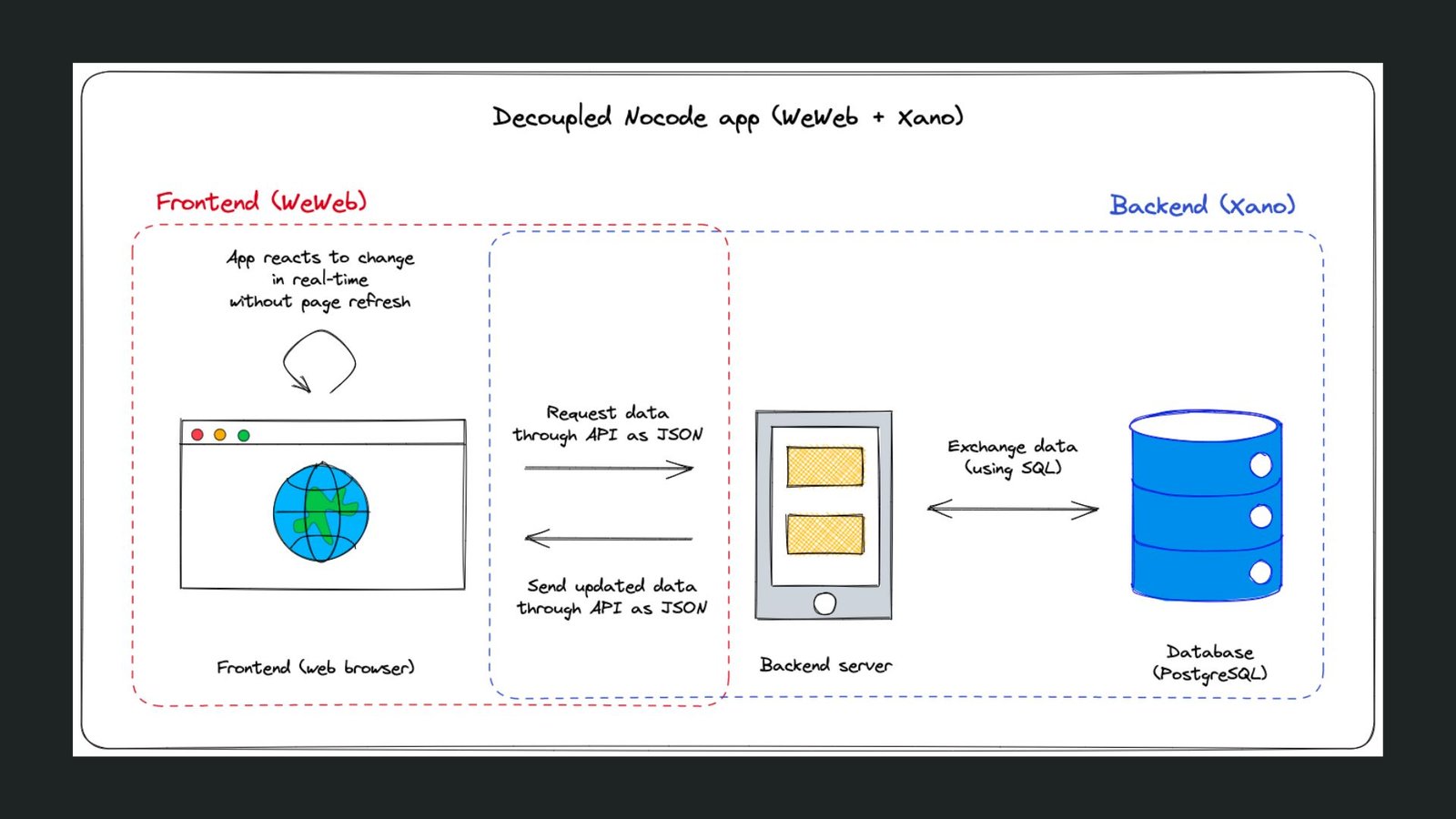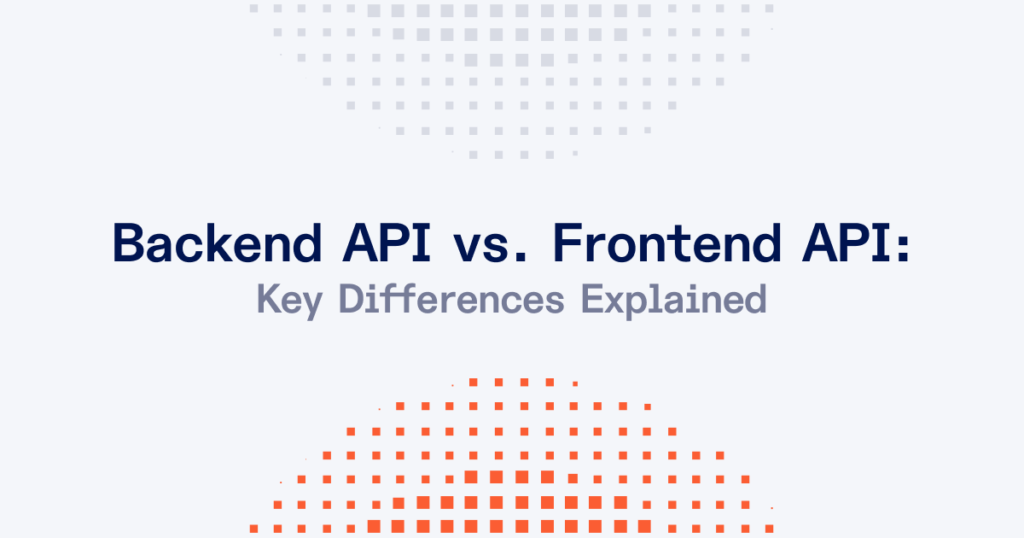Backend APIs handle server-side operations like database management and authentication, while frontend APIs manage client-side interactions, focusing on user interface and experience.
In the world of web development, APIs, or Application Programming Interfaces, are key. They allow different software applications to communicate with each other. Backend APIs handle the server-side operations, ensuring that the data and services requested are delivered. Frontend APIs, on the other hand, manage the client-side interactions, ensuring that the user interface responds smoothly.
Grasping the distinctions between these two types of APIs can help developers create more efficient and effective applications. This blog post will delve into the unique characteristics and roles of Backend and Frontend APIs. Understanding these differences can enhance your development skills and improve your projects.
Core Functions
Understanding the core functions of Backend and Frontend APIs is crucial. These APIs play different roles in web development. They help build robust, user-friendly applications.
Backend API Roles
Backend APIs manage data and server-side logic. They provide a bridge between the server and the database. The core functions of Backend APIs include:
- Data Management: Handle data storage, retrieval, and updates.
- Authentication: Ensure secure access to the application.
- Business Logic: Execute server-side operations and rules.
- Integration: Connect with external services and databases.
- Performance Optimization: Improve server response times and efficiency.
Frontend API Roles
Frontend APIs deal with user interface and user experience. They interact with the Backend APIs to fetch and display data. The core functions of Frontend APIs include:
- UI Updates: Dynamically update content on the webpage.
- User Interactions: Handle user inputs and actions.
- Data Fetching: Retrieve data from Backend APIs and show it.
- State Management: Maintain application state across various components.
- Performance Enhancement: Optimize front-end performance and user experience.
Both Backend and Frontend APIs are essential. They work together to create a seamless application.

Credit: www.techtarget.com
Architecture
Understanding the architecture of Backend APIs and Frontend APIs is crucial for developers. It helps in designing and implementing efficient web applications. This section explores the distinct structures of Backend and Frontend APIs.
Backend Structure
The Backend structure serves as the server side of an application. It handles data storage, management, and processing. Backend APIs connect with databases and perform server-side logic. They are usually built using languages like Python, Java, or Node.js.
Backend APIs also ensure security and data integrity. They authenticate and authorize users. Here is a simple example of a Backend API endpoint in Node.js:
const express = require('express');
const app = express();
app.get('/api/data', (req, res) => {
res.json({ message: 'Hello from Backend!' });
});
app.listen(3000, () => {
console.log('Server running on port 3000');
});
These APIs interact with databases and other services. They respond to HTTP requests from the client side. The Backend structure is crucial for the overall functionality and performance of a web application.
Frontend Structure
The Frontend structure focuses on the client side. It deals with the user interface and experience. Frontend APIs are integrated into web pages or mobile apps. They fetch data from Backend APIs and display it to users.
Frontend APIs are typically built using JavaScript, HTML, and CSS. Here is an example of a Frontend API call using JavaScript:
fetch('http://localhost:3000/api/data')
.then(response => response.json())
.then(data => {
console.log(data.message);
})
.catch(error => console.error('Error:', error));
Frontend APIs ensure smooth interaction with the backend. They handle user inputs and update the UI dynamically. This structure is essential for delivering a responsive and interactive user experience.
Both Backend and Frontend structures are vital for modern web applications. They work together to provide a seamless and efficient experience for users.
Data Handling
Data handling is a crucial aspect of web development, involving how data is processed and managed. Understanding the differences between backend APIs and frontend APIs in terms of data handling is essential. This section will explore data processing in both the backend and frontend, highlighting their unique approaches and responsibilities.
Data Processing In Backend
The backend API primarily handles data processing tasks. This involves the following:
- Data Storage: Backend servers manage data storage, often using databases.
- Data Manipulation: Backend processes handle data transformations, calculations, and aggregations.
- Data Security: Ensuring data integrity and security is a key responsibility.
- Business Logic: The backend implements the core logic and rules of the application.
Backend APIs often interact with databases, performing operations like:
- Fetching data
- Updating records
- Deleting entries
- Inserting new data
Here is a simple example of a backend API endpoint written in Node.js:
app.get('/api/data', (req, res) => {
db.find({}, (err, data) => {
if (err) {
res.status(500).send(err);
} else {
res.json(data);
}
});
});
Data Processing In Frontend
The frontend API focuses on presenting and manipulating data on the client side. Key aspects include:
- Data Display: Rendering data in the user interface.
- Data Validation: Ensuring user input meets required formats before sending to the backend.
- Data Interactivity: Allowing users to interact with data through forms and controls.
- Data Formatting: Formatting data for better readability.
Frontend APIs often interact with backend APIs by:
- Making HTTP requests
- Fetching and displaying data
- Submitting user input
- Handling responses and errors
Here is an example of a frontend API call using JavaScript:
fetch('/api/data')
.then(response => response.json())
.then(data => {
console.log(data);
})
.catch(error => {
console.error('Error fetching data:', error);
});
Both the backend and frontend APIs play crucial roles in data handling. The backend focuses on robust data processing and storage, while the frontend ensures smooth data presentation and user interaction.

Credit: www.weweb.io
Performance
Understanding the performance differences between backend and frontend APIs is essential. It impacts the user experience and efficiency of web applications. Let’s dive into the key factors affecting performance in both backend and frontend APIs.
Backend Performance Factors
Backend APIs handle data processing, storage, and communication with databases. Several factors influence their performance:
- Database Queries: Efficient queries reduce response time.
- Server Load: High traffic can slow the server.
- Scalability: Ability to handle growing user numbers.
- Latency: Time taken for data to travel between server and client.
Let’s see a quick comparison of backend performance factors:
| Factor | Impact |
|---|---|
| Database Queries | High impact on speed |
| Server Load | Moderate impact on speed |
| Scalability | High impact on handling more users |
| Latency | High impact on response time |
Frontend Performance Factors
Frontend APIs deal with the user interface and experience. Factors affecting their performance include:
- Render Time: Time to display content on the screen.
- API Response Time: Speed of data retrieval from the server.
- JavaScript Execution: Efficiency of scripts running in the browser.
- Resource Loading: Speed of loading images, CSS, and other assets.
Here’s a comparison of frontend performance factors:
| Factor | Impact |
|---|---|
| Render Time | High impact on user experience |
| API Response Time | Moderate impact on speed |
| JavaScript Execution | High impact on interactivity |
| Resource Loading | High impact on page load time |
Understanding these performance factors helps in building efficient web applications. Both backend and frontend APIs need optimization to provide a seamless user experience.
Security
Security is a critical aspect of both Backend APIs and Frontend APIs. Each has its own set of security measures to protect data and ensure privacy. Understanding these measures is key to building secure applications.
Backend Security Measures
Backend APIs handle sensitive data and core business logic. Security in the backend is crucial. Several measures are taken to ensure data protection:
- Authentication and Authorization: Only authenticated users can access certain resources. Authorization ensures they have the right permissions.
- Data Encryption: Data is encrypted both in transit and at rest. This prevents unauthorized access.
- Input Validation: Validating all inputs helps prevent SQL injection and other attacks.
- Rate Limiting: Limits the number of requests a user can make. This helps prevent Denial of Service (DoS) attacks.
These measures help keep the backend secure. They protect both the server and the data.
Frontend Security Measures
Frontend APIs interact directly with users. Security here focuses on protecting the user and the user interface. Key measures include:
- HTTPS: Ensures all communication between the client and server is encrypted.
- Content Security Policy (CSP): Prevents cross-site scripting (XSS) attacks. It restricts sources of content that can be loaded.
- Sanitizing Inputs: Ensures user inputs do not contain malicious code.
- Token Management: Uses tokens for secure authentication. Tokens are stored securely on the client side.
These measures help secure the frontend. They protect user data and the integrity of the user interface.
Use Cases
The use cases for backend and frontend APIs differ based on their functions in a web application. Understanding when to use each type can optimize performance and user experience. Let’s explore the specific scenarios where each is applicable.
When To Use Backend API
Backend APIs handle data processing and storage. They are essential for:
- Database operations: Fetching, updating, and deleting data from a database.
- Authentication: Verifying user credentials and managing sessions.
- Server-side logic: Complex calculations or data manipulations that occur on the server.
- Third-party integrations: Communicating with external services like payment gateways or email services.
Backend APIs ensure secure and efficient data handling. They are crucial for maintaining the integrity and reliability of the application.
When To Use Frontend API
Frontend APIs focus on user interface and experience. They are useful for:
- Dynamic content: Fetching data to display in real-time without reloading the page.
- User interactions: Handling actions like form submissions or button clicks.
- Client-side validation: Checking input data before sending it to the server.
- UI updates: Changing the appearance or content of the page based on user actions.
Frontend APIs enhance user experience by making web applications more interactive and responsive. They play a vital role in delivering a seamless and engaging user interface.
Tools And Technologies
Understanding the tools and technologies used in backend and frontend APIs is crucial. They help developers create efficient, user-friendly applications. Each side uses different tools and technologies, tailored to their specific requirements.
Popular Backend Tools
Backend development focuses on server-side functionality. Here are some popular backend tools:
- Node.js: A runtime environment for executing JavaScript on the server.
- Express.js: A web application framework for Node.js.
- Django: A high-level Python web framework.
- Ruby on Rails: A server-side web application framework written in Ruby.
- Flask: A micro web framework for Python.
- Spring Boot: A Java-based framework for building microservices.
Popular Frontend Tools
Frontend development focuses on the client-side, ensuring a smooth user experience. Here are some popular frontend tools:
- React: A JavaScript library for building user interfaces.
- Vue.js: A progressive JavaScript framework for building UIs.
- Angular: A platform for building mobile and desktop web applications.
- Bootstrap: A CSS framework for creating responsive designs.
- SASS: A preprocessor scripting language that is interpreted or compiled into CSS.
- Webpack: A module bundler for JavaScript applications.
Challenges
Understanding the challenges faced by backend and frontend APIs is crucial for web development. Each side of the API has unique issues that developers must handle. Let’s dive into these specific challenges.
Backend API Challenges
Backend APIs face several unique challenges that can affect performance and reliability:
- Scalability: Handling a large number of requests can be tough. Ensuring the backend can scale effectively is crucial.
- Security: Protecting sensitive data from unauthorized access is vital. Implementing strong authentication and authorization is necessary.
- Data Management: Managing and storing data efficiently is a common challenge. Ensuring data integrity and consistency is essential.
- Performance: Optimizing server response times is important. Slow APIs can lead to a poor user experience.
- Integration: Integrating with other services and databases can be complex. Ensuring seamless communication between systems is key.
Frontend API Challenges
Frontend APIs also face distinct challenges that can impact user experience and functionality:
- Compatibility: Ensuring the API works across different browsers and devices is critical. Inconsistent behavior can frustrate users.
- Usability: Designing intuitive and easy-to-use APIs is important. Complex interfaces can confuse users.
- Performance: Minimizing the load times and ensuring smooth interactions is crucial. Slow frontend APIs can degrade the user experience.
- Error Handling: Properly managing and displaying error messages is necessary. Clear and helpful errors improve user satisfaction.
- Security: Protecting the frontend from potential vulnerabilities is key. Implementing secure coding practices is essential.
Future Trends
As technology evolves, so do the tools and methods used in APIs. Both backend and frontend APIs continue to see significant advancements. These improvements aim to enhance performance, security, and developer experience.
Innovations In Backend Apis
Backend APIs are critical for managing data and server-side logic. Several key trends are shaping their future:
- Microservices Architecture: This approach breaks down applications into smaller, independent services. Each service can be developed, deployed, and scaled individually.
- GraphQL Adoption: GraphQL allows clients to request specific data, reducing the amount of data transferred. This method improves efficiency and flexibility.
- Serverless Computing: Serverless models let developers run backend services without managing server infrastructure. This leads to cost savings and improved scalability.
- API Security Enhancements: Stronger security protocols are being implemented to protect data. Examples include OAuth 2.0 and API gateways.
Innovations In Frontend Apis
Frontend APIs focus on delivering a smooth user experience. They are seeing several exciting developments:
- WebAssembly (Wasm): WebAssembly speeds up web applications by running code closer to native performance. It allows developers to use languages like C++ or Rust on the web.
- Progressive Web Apps (PWAs): PWAs provide a native app-like experience on the web. They work offline and have better performance.
- Single Page Applications (SPAs): SPAs load a single HTML page and dynamically update it. This technique improves speed and provides a seamless user experience.
- Component-Based Frameworks: Frameworks like React and Vue.js allow for reusable components. These components simplify development and improve code maintainability.
Both backend and frontend APIs are advancing rapidly. Staying updated on these trends helps developers create better, more efficient applications.

Credit: www.index.dev
Frequently Asked Questions
What Is A Backend API?
A Backend API is a server-side interface that handles data processing and storage. It communicates with databases and other services to manage information.
What Is A Frontend API?
A Frontend API is a client-side interface that interacts with user interfaces. It handles the presentation layer, enabling dynamic content and user interactions.
How Do the Backend And Frontend APIs Differ?
Backend APIs manage server-side operations and data processing. Frontend APIs focus on user interfaces and presentation layers. They serve different roles.
Can Backend And Frontend APIs Work Together?
Yes, Backend and Frontend APIs often work together. The Backend API handles data, while the Frontend API presents it to users.
Conclusion
Understanding the differences between Backend and Frontend APIs is crucial. Backend APIs manage server-side tasks. Frontend APIs handle user interfaces. Both are essential for modern web applications. They work together, creating seamless user experiences. Knowing their roles helps in better project planning.
This knowledge can also improve collaboration between developers. Always consider the specific needs of your project. Make informed decisions based on these differences. This approach ensures efficient and effective application development.

